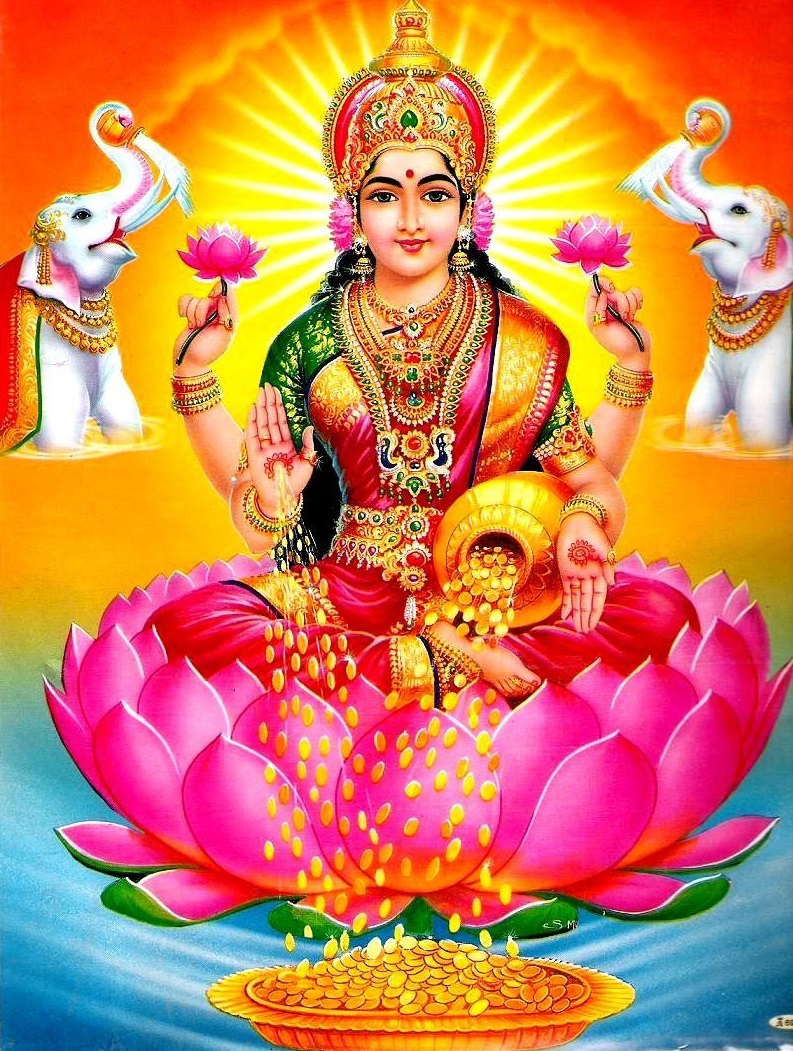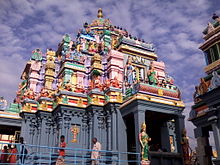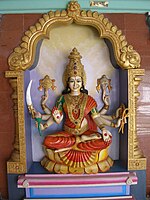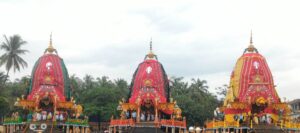
Lakshmi Sanskrit : लक्ष्मी Lakṣmī meaning literally – ’she who leads to one’s goal’), also known as Shri (Sanskrit: श्री literally ’Noble’) is one of the principal goddesses in Hinduism. She is the goddess of wealth, fortune, power, beauty and prosperity and associated with Maya (“Illusion”). Along with Parvati and Saraswati, she forms the Tridevi of Hindu goddesses

WHO IS GODDESS LAKSHMI ?
- Lakshmi Sanskrit : लक्ष्मी Lakṣmī meaning literally – ’she who leads to one’s goal’), also known as Shri (Sanskrit: श्री literally ’Noble’) is one of the principal goddesses in Hinduism
- She is the goddess of wealth, fortune, power, beauty and prosperity and associated with Maya (“Illusion”)
- Along with Parvati and Saraswati, she forms the Tridevi of Hindu goddesses
- Within the Goddess-oriented Shaktism, Lakshmi is venerated as a principle aspect of the Mother goddess
- Lakshmi is both the wife and divine energy (shakti) of the Hindu god Vishnu, the Supreme Being of Vaishnavism
- Lakshmi is also the Supreme Goddess in the sect and assists Vishnu to create, protect and transform the universe
- Whenever Vishnu descended on the earth as an avatar, Lakshmi accompanied him as consort, for example as Sita and Radha or Rukmini as consorts of Vishnu’s avatars Rama and Krishna respectively
- The eight prominent manifestations of Lakshmi, the Ashtalakshmi symbolize the eight sources of wealth
- Lakshmi is depicted in Indian art as an elegantly dressed, prosperity-showering golden-coloured woman standing or siting in padmasana on a lotus throne, while holding a lotus in her hand, symbolizing fortune, self-knowledge, and spiritual liberation
- Archaeological discoveries and ancient coins suggest the recognition and reverence for Lakshmi existing by the 1st millennium BCE
- Lakshmi’s iconography and statues have also been found in Hindu temples throughout Southeast Asia, estimated to be from the second half of the 1st millennium CE
- The festivals of Diwali and Sharad Purnima (Kojagiri Purnima) are celebrated in her honor
| Other names | Sri, Narayani, Bhargavi, Bhagavati, Padma, Kamala, Vaishnavi |
|---|---|
| Devanagari | लक्ष्मी |
| Affiliation | Devi, Tridevi, Ashta Lakshmi, Shakti, Mahadevi |
| Abode | Vaikuntha, Manidvipa |
| Mantra | ॐ श्रीं श्रियें नमः। (Om Shri Shriye Namaha), ॐ श्रीं महालक्ष्म्यै नमः। (Om Shreem Maha Lakshmiyei Namaha), ॐ श्री महालक्ष्म्यै नमः। (Om Shri Mahalakshmiyei Namaha) |
| Symbols | Padma (Lotus), Shankha (conch), Discus, Gada (mace), Jnana Mudra, Abhaya Mudra, gold, coins, |
| Mount | Lotus and Elephant |
| Festivals | Diwali (Lakshmi Puja), Sharad Purnima, Varalakshmi Vratam, Navaratri, Sankranti |
| Personal information | |
|---|---|
| Siblings | Jyestha or Alakshmi |
| Consort | Vishnu |
WHAT IS THE SYMBOLISM & ICONOGRAPHY OF GODDESS LAKSHMI ?
- Her name is derived from Sanskrit root words for knowing the goal and understanding the objective
- Her iconography shows her with four hands, which represent the four aspects of human life important to Hindu culture: dharma, kāma, artha, and moksha
- Her four arms are symbolic of the four goals of humanity that are considered good in Hinduism :
- DHARMA – Pursuit of ethical, moral life
- ARTHA – Pursuit of wealth, means of life
- KAMA – Pursuit of love, emotional fulfillment and
- MOKSHA – Pursuit of self-knowledge, liberation
- In Lakshmi’s iconography, she is either sitting or standing on a lotus and typically carrying a lotus in one or two hands
- The lotus carries symbolic meanings in Hinduism and other Indian traditions
- Lotus symbolizes knowledge, self-realization, and liberation in the Vedic context, and represents reality, consciousness, and karma (‘work, deed’) in the Tantra (Sahasrara) context
- The lotus, a flower that blooms in clean or dirty water, also symbolizes purity regardless of the good or bad circumstances in which it grows
- It is a reminder that good and prosperity can bloom and not be affected by evil in one’s surroundings
- Below, behind, or on the sides, Lakshmi is very often shown with one or two elephants, known as Gajalakshmi and occasionally with an owl
- Elephants symbolize work, activity, and strength, as well as water, rain and fertility for abundant prosperity
- The owl signifies the patient striving to observe, see, and discover knowledge, particularly when surrounded by darkness
- As a bird reputedly blinded by daylight, the owl also serves as a symbolic reminder to refrain from blindness and greed after knowledge and wealth have been acquired
- Goddess Lakshmi is also mounted on Lions sometimes and represents the Goddess of strength
- In some representations, wealth either symbolically pours out from one of her hands or she simply holds a jar of money
- This symbolism has a dual meaning: wealth manifested through Lakshmi means both materials as well as spiritual wealth
- Her face and open hands are in a mudra that signifies compassion, giving or dāna (‘charity’)
- Lakshmi typically wears a red dress embroidered with golden threads, which symbolizes fortune and wealth
- She, goddess of wealth and prosperity, is often represented with her husband Vishnu, the god who maintains human life filled with justice and peace
- This symbolism implies wealth and prosperity are coupled with the maintenance of life, justice, and peace
DESCRIBE THE MANIFESTATION ASPECTS OF GODDESS LAKSHMI
- Inside temples – Lakshmi is often shown together with Vishnu
- In certain parts of India, Lakshmi plays a special role as the mediator between her husband Vishnu and his worldly devotees
- When asking Vishnu for grace or forgiveness, the devotees often approach Him through the intermediary presence of Lakshmi
- She is also the personification of spiritual fulfillment
- Lakshmi embodies the spiritual world, also known as Vaikuntha, the abode of Lakshmi and Vishnu (collectively called Lakshmi Narayana
- Lakshmi is the embodiment of the creative energy of Vishnu and primordial Prakriti who creates the universe
- Lakshmi, Saraswati, and Parvati are typically conceptualized as distinct in most of India, but in states such as West Bengal and Odisha, they are regionally believed to be forms of Durga
- In Hindu Bengali culture Lakshmi along with Saraswati, are seen as the daughters of Durga
- They are worshipped during Durga Puja
- In South India, Lakshmi is seen in two forms – Sridevi and Bhudevi, both at the sides of Venkateshwara, a form of Vishnu
- Bhudevi is the representation and totality of the material world or energy, called the Apara Prakriti, or Mother Earth
- Sridevi is the spiritual world or energy called the Prakriti
GODDESS LAKSHMI – WORSHIP & FESTIVALS
DIWALI
-
Diwali celebrations include puja (prayers) to Lakshmi and Ganesha
-
Lakshmi is of the Vaishnavism tradition, while Ganesha of the Shaivism tradition of Hinduism
- Many Hindus worship Lakshmi on Diwali, the festival of lights
- It is celebrated in autumn, typically October or November every year
- The festival spiritually signifies the victory of light over darkness, knowledge over ignorance, good over evil and hope over despair
- Before Diwali night, people clean, renovate and decorate their homes and offices
- On Diwali night, Hindus dress up in new clothes or their best outfits, light up diyas (lamps and candles) inside and outside their home, and participate in family puja (prayers) typically to Lakshmi
- After puja, fireworks follow – then a family feast including mithai (sweets), and an exchange of gifts between family members and close friends
- Diwali also marks a major shopping period, since Lakshmi connotes auspiciousness, wealth and prosperity
- This festival dedicated to Lakshmi is considered by Hindus to be one of the most important and joyous festivals of the year
- Gaja Lakshmi Puja is another autumn festival celebrated on Sharad Purnima in many parts of India on the full-moon day in the month of Ashvin (October)
- Sharad Purnima, also called Kojaagari Purnima or Kuanr Purnima, is a harvest festival marking the end of monsoon season
- There is a traditional celebration of the moon called the Kaumudi celebration, Kaumudi meaning moonlight
- On Sharad Purnima night, goddess Lakshmi is thanked and worshipped for the harvests
- Vaibhav Lakshmi Vrata is observed on Friday for prosperity
GODDESS LAKSHMI : SOME TEMPLES
- In Maharashtra, as Ambabai or Mahalakshmi in Mahalakshmi Temple, Kolhapur (Shakti peetha), Mahalakshmi Temple, Dahanu
- In Karnataka, as Mookambika in Mookambika Temple, Kollur
- In Kerala, as Bhagavathi in Chottanikkara Temple,
- In Andhra Pradesh, as Kanaka Mahalakshmi in Sri Kanaka Maha Lakshmi
- In Tamil Nadu, as Lakshmi Narayani in Golden Temple, Sripuram, as Ashtalakshmi in Ashtalakshmi Temple, Chennai, other prominent tamples include – Thirunarayur Nambi Temple, Andal temple, Srivilliputhur, Azhagiya Manavala Perumal Temple, Pundarikakshan Perumal Temple,
- In Madhya Pradesh, as Lakshmi in Lakshmi Temple, Khajuraho
GODDESS LAKSHMI : HYMNS
Countless hymns, prayers, shlokas, stotra, songs, and legends dedicated to Mahalakshmi are recited during the ritual worship of Lakshmi. Some of the key ones include Sri Lalitha Sahasranamam, Sri Mahalakshmi Ashtakam and many others
WHAT IS ASHTA LAKSHMI ? THE 8 FORMS OF LAKSHMI
Ashta Lakshmi (Sanskrit: अष्टलक्ष्मी, Aṣṭalakṣmī, ‘eight Lakshmis’) is a group of eight secondary manifestations of Lakshmi
The Ashta Lakshmi presides over eight sources of wealth and thus represents the eight powers of Shri
Lakshmi Temples dedicated to Ashta Lakshmi are Ashtalakshmi Kovil near Chennai and many other places in and outside India
| Adi Lakshmi | The First manifestation of Lakshmi |
| Dhanya Lakshmi | Granary Wealth |
| Veera Lakshmi | Wealth of Courage |
| Gaja Lakshmi | Elephants spraying water, the wealth of fertility, rains, and food |
| Santana Lakshmi | Wealth of Continuity, Progeny |
| Vidya Lakshmi | Wealth of Knowledge and Wisdom |
| Vijaya Lakshmi | Wealth of Victory |
| Dhana / Aishwarya Lakshmi | Wealth of prosperity and fortune |
| Ashta Lakshmi | |
|---|---|
|
All Eight forms of Wealth
|
- Ashta Lakshmi (Sanskrit: अष्टलक्ष्मी : literally meaning”Eight Lakshmis”) or Ashtalakshmi are a group of eight manifestations of Devi Lakshmi, the Hindu goddess of wealth
- She presides over eight sources of wealth : “Wealth” in the context of Ashta-Lakshmi means prosperity, fertility, good fortune or good luck, good health, knowledge, strength, progeny and power
- The Ashta Lakshmi are always depicted and worshipped in a group in temples
| Affiliation | Forms of Lakshmi |
|---|---|
| Abode | Vaikuntha Loka, Manidvipa |
| Mantra | oṁ aim hrīṁ śrīṁ mahālakṣmyai namo namaḥ |
| Weapon | Khanda (sword), Bow and Arrow, Trishula (Trident), Chakra (discus), Gada (mace), Ankusha (goad) and Shield |
| Mount | Lotus, owl, eagle, lion, elephant |
| Consort | Vishnu |
ASHTA LAKSHMI : ETYMOLOGY, SYMBOLISM & ICONOGRAPHY OF THE 8 FORMS OF GODDESS LAKSHMI
The prayer “Shri Ashta Lakshmi Stotram” lists all of the Ashta Lakshmis in which all of the Ashta Lakshmis are depicted as seated on a lotus
|
|
Adi Lakshmi – The First manifestation of Lakshmi
|
|
Dhanya Lakshmi – Granary Wealth
|
|
|
|
Veera Lakshmi – Wealth of Courage
|
|
Gaja Lakshmi – Elephants spraying water, the wealth of fertility, rains, and food
|
|
|
|
Santana Lakshmi – Wealth of Continuity, Progeny
|
|
|
Vidya Lakshmi – Wealth of Knowledge and Wisdom
|
|
|
Vijaya Lakshmi – Wealth of Victory
|
|
Dhana / Aishwarya Lakshmi – Wealth of prosperity and fortune
|
- Aishwarya Lakshmi (“Prosperity Lakshmi”) : Goddess of riches only form of Lakshmi which mounts a horse. She generally replaces Vidya Lakshmi from the Ashtalakshmi list.
- Saubhāgya Lakshmi (“Giver of good Fortune”) : Giver of prosperity in general
- Rājya Lakshmi (“Royal Lakshmi”): “She who blesses rulers (with power)”
- Vara Lakshmi (“Boon Lakshmi”): “The goddess who bestows boons”
ASHTA LAKSHMI TEMPLES
 Ashtalakshmi Kovil – Temple of Eight Lakshmi’s, Chennai, Tamil Nadu, India
Ashtalakshmi Kovil – Temple of Eight Lakshmi’s, Chennai, Tamil Nadu, India- Ashtalakshmi Temple, Besant Nagar, Chennai, Tamil Nadu, India : The Ashta Lakshmi Kovil, built in 1974, is the first shrine dedicated exclusively to the Ashta Lakshmi where Lakshmi is given greater importance than Vishnu. It has eight small shrines arranged in clockwise direction, dedicated to the Ashta Lakshmi and then a ninth shrine dedicated to Vishnu and Lakshmi together, unlike the traditional separate shrines
- Ashtalakshmi Temple, Vasavi Colony, Dilsukh Nagar, Hyderabad, Andhra Pradesh, India
- Sydney Durga Temple – The Hindu Temple, located in Regents Park, Sydney, Australia has 8 small sanctums dedicated to the Ashta Lakshmi
- Ashtalakshmi Temple, Sugar Land, Houston, Texas, United States
- Ashtalakshmi Temple, North Hollywood, California, United States
- At the entrance – leading from Vittavasal Street to Meenakshi Temple, Madhurai, a mandapam (Hall) called Ashta Lakshmi Mandapam is dedicated to the Ashta Lakshmi, the statues of which support the roof on either side.
- Parashakthi Temple, Pontiac, Michigan has the deities installed there
- Asta Lakshmi Devasthanam, Fremont, California. Address incorrect, call to find out
- Sree Vasudevapuram Mahavishnu temple situated in Ernakulam district of Kerala India conducts the ASHTALAKSHMI THAMPOOLASAMRPANA MAHOTSAVAM every year starting on the eve of Akshaya Tritheye. The belief is that Maha Lakshmi gives darshan and shower blessings on devotees only on eight days in a year as Ashta Lakshmis. The most auspicious ritual of the temple known as ‘’Thampoolasamarpanam” is performed during the mahotsavam
ASHTALAKSHMI TEMPLE : CHENNAI


- The Ashtalakshmi Kovil is a Hindu temple, which lies on the shorelines near the Elliot’s beach, in Chennai, India
- The temple is dedicated to the goddess Lakshmi, and her eight primary forms – the Ashtalakshmi – the giver of all eight forms of wealth, namely, offspring, success, prosperity, wealth, courage, bravery, food, and knowledge
- The sanctorums are depicted on a multi-tier complex in such a way that visitors could visit all the shrines without stepping over any of the sanctorums
- The foundation was laid in January 1974 by public participation
- The consecration of the temple took place on 5 April 1976
- The temple measures 65 ft in length and 45 ft in breath
- It is modeled after the Sundhararaja Perumal Temple in Uthiramerur
- In this temple, the Ashtalakshmis, the eight forms of goddess Lakshmi, are present in four levels in nine separate sanctums
- The shrine of Lakshmi and her consort Vishnu is in level two
- One starts the worship from here
- Taking the stairs, the path leads to the third floor, which has the shrines of Santhanalakshmi, Vijayalakshmi, Vidyalakshmi and Gajalakshmi
- Further few steps would lead to the shrine of Dhanalakshmi, which is the only shrine on the fourth floor
- Exiting the main shrine, in the first level, there are shrines for Aadilakshmi, Dhaanya lakshmi and Dharyalakshmi
- The temple also has Dashavatara (avatars of Vishnu), Guruvayoorappan, Ganesha, Dhanwanthari and Anjaneyar deities
GODDESS LAKSHMI WORSHIP
VARALAKSHMI VRATAM
- Varalakshmi is one who grants boons (“Vara”). It is an important pooja performed by many women in the states of Karnataka, Andhra Pradesh, Telangana,Tamil Nadu and northern Sri Lanka
- The Hindu festival going by the name ‘Vara MahaLakshmi Vrata’ is celebrated on the Second Friday or the Friday before the day of the full moon – Poornima – in the month of Shravana, which corresponds to the Gregorian months of July–August
- Varamahalakshmi Vrata is performed by women for their own well being and that of all their family members
- It is believed that worshipping the Goddess Varalakshmi on this day is equivalent to worshipping Ashtalakshmi – the eight goddesses of Wealth, Earth, Wisdom, Love, Fame, Peace, Contentment, and Strength
- Due to the rising popularity of this holy day in some states, it is now being declared as an optional official holiday in India
- Worship Varalakshmi (Vara = boon, Lakshmi = goddess of wealth) and seek to fulfill wishes
- Varalakshmi is yet another form of Lakshmi, the goddess of wealth
- The prayer / worship was prescribed to be offered on the Friday of Shravana month preceding the night of the full moon
- On this occasion, women worship Goddess Lakshmi with utmost devotion offering fruits, sweets and flowers, usually a kalasam (representing the deity) will be decorated with a saree, flowers and gold jewelry with offerings placed in front
- A rakshai/saradu (sacred thread) is among the offerings and adorned on the wrists of women after the pooja has been completed
- This is worn to signify protection and piety, and several articles are given as gifts and charity in good faith
- This pooja can be performed with no restriction to caste or creed
- To this day, many women observe this traditional festival praying to Varamahalakshmi for her blessings in the form of wealth and well being of their family
- Eight forces or energies are recognised and they are known as Siri (Wealth), Bhu (Earth), Sarasvathi (Wisdom), Preethi (Love), Keerthi (Fame), Shanthi (Peace), Santhushti (contentment) and Pushti (Strength)
- Each one of these forces is called a ‘Lakshmi’ aka :
- Aadi Lakshmi (the Protector)
- Dhana Lakshmi (Goddess of Wealth)
- Dhairya Lakshmi (Goddess of Courage)
- Sowbhagya Lakshmi (Goddess of Prosperity)
- Vijaya Lakshmi (Goddess of Victory)
- Dhanya Lakshmi (Goddess of Nourishment)
- Santaana Lakshmi (Goddess of Progeny)
- Vidhya Lakshmi (Goddess of Wisdom)
- All the eight forces combined are called the Ashta Lakshmis or the eight Lakshmis of the Hindus
- Women who sought boons (varam) for the health, wealth and knowledge for the entire family
- The prescribed day for the pooja is the Friday of the month of Sravan in the fortnight known as Sukla paksha, preceding the full moon day









